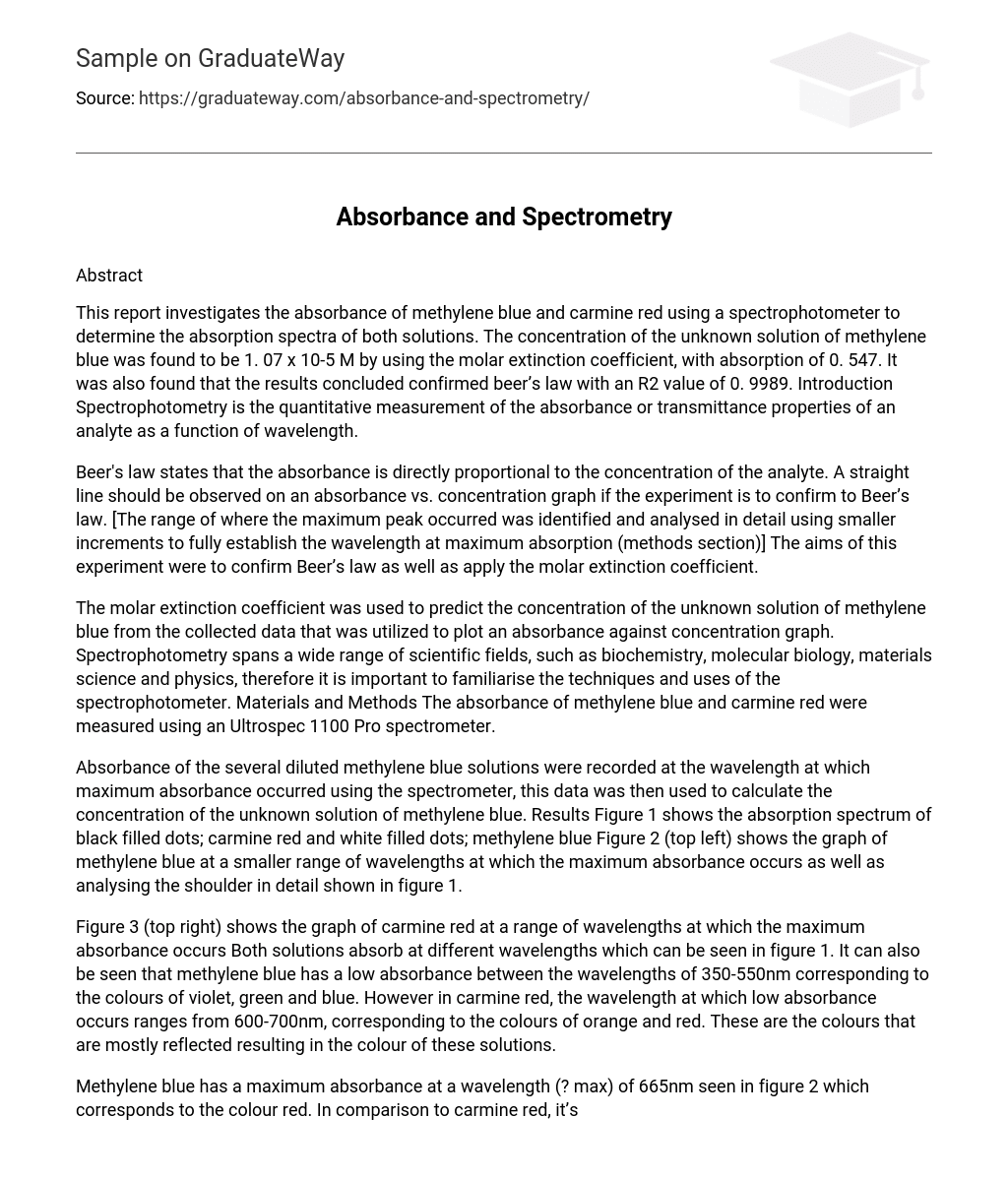Abstract
The report aims to investigate the absorbance of methylene blue and carmine red by utilizing a spectrophotometer. The absorption spectra of both solutions were determined using this instrument. Through the use of the molar extinction coefficient, the concentration of the unknown methylene blue solution was found to be 1.07 x 10-5 M, with an absorption value of 0.547. These findings provided confirmation for Beer’s law, as evidenced by an R2 value of 0.9989. This research utilized spectrophotometry to quantitatively measure the wavelength-dependent absorbance or transmittance properties of an analyte.
Beer’s law states that the concentration of the analyte is directly proportional to the absorbance. In order to validate Beer’s law, it is crucial to observe a linear relationship on a graph depicting absorbance versus concentration. The objective of the experiment was twofold: first, to verify Beer’s law and second, to utilize the molar extinction coefficient by examining and analyzing in detail the specific range where the highest peak occurred. This involved using smaller increments to determine the wavelength at which maximum absorption took place (as described in the methods section).
The data collected was used to create a graph that displays the relationship between absorbance and concentration for an unidentified methylene blue solution. Spectrophotometry is widely applied in scientific disciplines such as biochemistry, molecular biology, materials science, and physics. Hence, it is crucial to familiarize oneself with spectrophotometer techniques and applications. In this research, the Ultrospec 1100 Pro spectrometer was utilized to measure the absorbance of both methylene blue and carmine red.
A spectrometer was used to record the absorbance of various diluted methylene blue solutions at the wavelength where maximum absorbance occurred. The concentration of an unknown solution of methylene blue was calculated using this data. Figure 1 displays the absorption spectrum, indicating black filled dots for carmine red and white filled dots for methylene blue. Figure 2 (top left) illustrates the graph of methylene blue at a narrower range of wavelengths where maximum absorbance occurs, as well as providing a detailed analysis of the shoulder shown in figure 1.
Figure 3 (top right) depicts the graph of carmine red wavelengths with maximum absorbance. Both solutions display absorption at distinct wavelengths, as illustrated in figure 1. It is evident that methylene blue exhibits low absorbance from 350-550nm, which aligns with the colors violet, green, and blue. Conversely, carmine red exhibits low absorbance within the range of 600-700nm, corresponding to the colors orange and red. These are the predominant colors reflected by these solutions, hence determining their overall color appearance.
The color red corresponds to a wavelength of 665nm, which is the maximum absorbance for methylene blue as shown in figure 2. In comparison, carmine red has its maximum absorbance at a wavelength of 575nm, corresponding to the color green-yellow, as seen in figure 3. Figure 1 shows a shoulder for methylene blue between the wavelengths of 625-650nm. Further analysis of this can be found in the discussions section. Figure 4 displays the calibration curve for methylene blue concentration, indicating a linear relationship between concentration and absorbance, which aligns with Beer’s law.
This text shows that the concentration of solutes directly affects the absorbance of light. Although R2 is nearly 1, there were some limitations encountered during the experiment, which are further discussed in the discussions section. The concentration of the unknown methylene blue solution can be found in Appendix A, calculation 2. In the discussions and conclusion, it is mentioned that the graph follows Beer’s law, stating that absorbance is proportional to analyte concentration. However, limitations in this experiment may have caused distortions in the graphs and R2 value. Appendix B, tables 2 and 3 demonstrate that average absorbance was calculated differently from what is shown in Appendix B, table 1 due to variations in repetitions. One reason for this discrepancy was dust particles present in cuvettes which reflected light and hindered absorption. To prevent this error, it is recommended to clean cuvettes with distilled water, dry them by blotting, and store them upside down in a designated plastic rack to remove excess water.
In the results section, the graph analysis for methylene blue was conducted in smaller wavelength intervals (625-675nm), as shown in figure 2. This analysis confirmed that there were no measurement errors. However, a limitation arose from parallax error during the dilution of methylene blue, resulting in a lower R2 value compared to expected. To mitigate this parallax error, measurements were taken parallel to the water surface using a pipette. More details can be found in the Appendices.
Appendix A – Calculations: Methylene blue (0.005%) in water was utilized. A 0.0005% wt/vol solution contains 0.0005g solute per 100ml or 0.005g solute per 1L. By employing the molar mass (Mr) of methylene blue, which is 319.5g mol-1, a concentration of 1.56 x 10-5 M was achieved through the moles calculation of mass.
Calculation
The unknown solution of methylene blue had an absorbance of 0.547Au. By using Beer’s law A=kct, we were able to calculate its concentration. Substituting A=0.547, k=51009, and t=1 into the equation gives C=0.547/51009, resulting in a concentration of 1.07 x 10-5 M.





